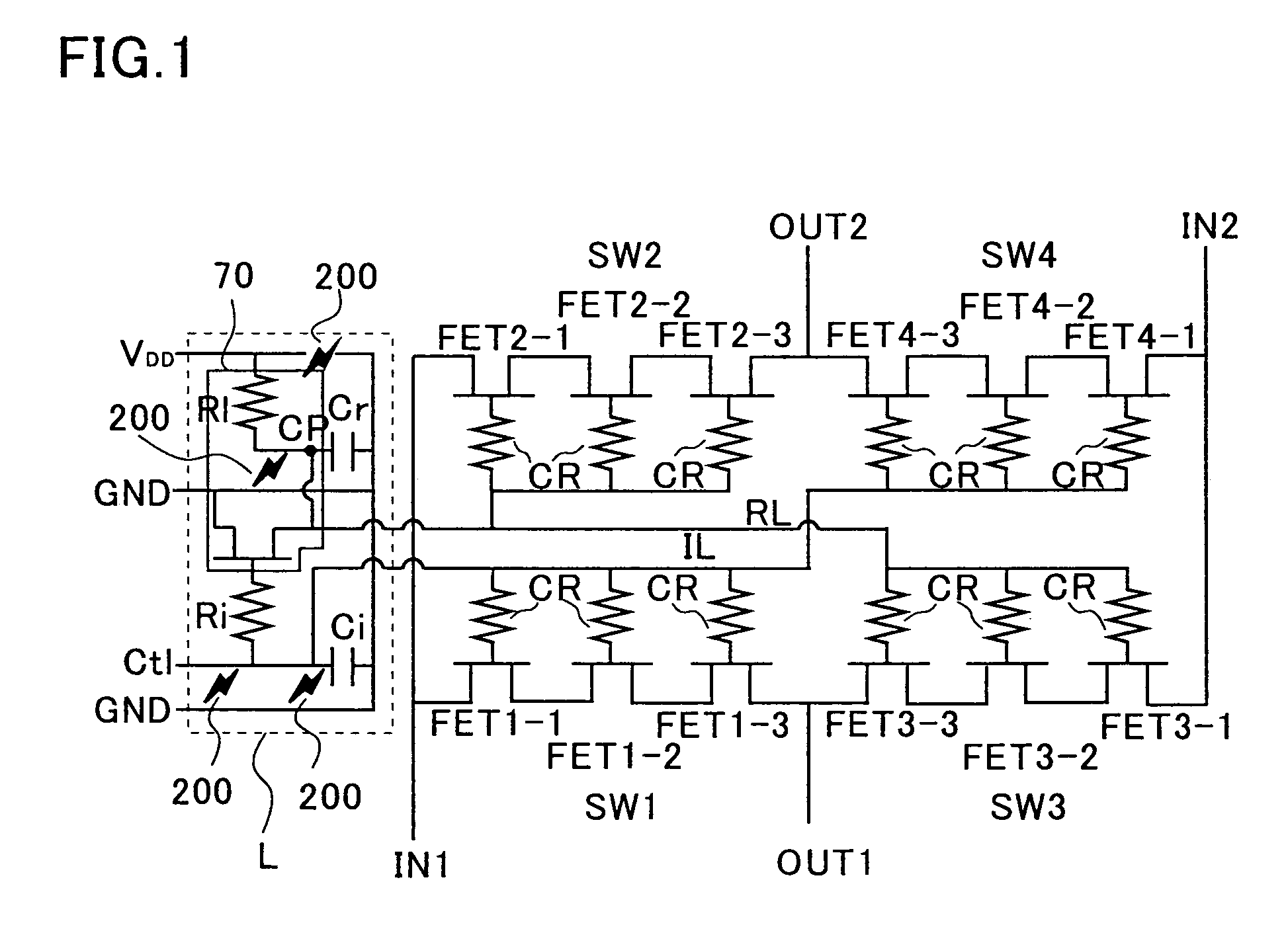Compound semiconductor switching circuit device
a switching circuit and semiconductor technology, applied in the field of compound semiconductor switching circuit devices, can solve the problems of increasing manufacturing costs, small size of logic circuits, and extremely vulnerable to static electricity,
- Summary
- Abstract
- Description
- Claims
- Application Information
AI Technical Summary
Benefits of technology
Problems solved by technology
Method used
Image
Examples
first embodiment
[0032]the present invention will now be explained while referring to FIGS. 1 to 8. FIG. 1 is a circuit diagram showing an example DPDT (Double Pole Double Throw) switching MMIC that includes four switching elements, each of which is formed by connecting a plurality of FETs.
[0033]The DPDT is a switching MMIC that is employed, for example, for a CDMA (Code Division Multiple Access) mobile phone, and includes: first to fourth switching elements SW1, SW2, SW3 and SW4; two first RF ports (first common input terminal IN1 and second common input terminal IN2); and two second RF ports (first common output terminal OUT1 and second common output terminal OUT2). In this arrangement, a SPDT switch, constituted by the first and second switching elements SW1 and SW2, and another SPDT switch, constituted by the third and fourth switching elements SW3 and SW4, are connected by the second RF ports.
[0034]The switching elements SW1, SW2, SW3 and SW4 are FET groups, each of which is formed by connectin...
second embodiment
[0123]the present invention will now be described while referring to FIGS. 9 and 10. FIG. 9 is a circuit diagram, and FIG. 10 is a plan view.
[0124]The second embodiment is a case wherein no second ground terminal pad G2 is provided. Lower electrode 55i of capacitor Ci and lower electrode 55r of capacitor Cr are continuous and are connected to first ground terminal pad G. That is, logic circuit L normally operates when the second ground terminal pad G2 of the first embodiment (FIG. 2) is not provided. According to the second embodiment, the protecting element 200 (FIG. 5) indicated by a line b-b in FIG. 2 is not connected. However, by employing the protecting element 200 (FIG. 6), indicated by a line c-c in FIG. 2, devices between control terminal Ctl and ground terminal GND can be protected.
[0125]Since other components are the same as those in the first embodiment, no further explanation for them will be given.
third embodiment
[0126]the present invention will now be explained while referring to FIGS. 11 to 14. FIG. 11 is a circuit diagram showing a switching circuit device, FIG. 12 is a plan view of a switching circuit device, FIGS. 13A and 13B are cross-sectional views of devices that constitute an inverter, and FIG. 14 is a cross-sectional view of a protecting element.
[0127]According to the third embodiment, inverter 70 is called an E / D type DCFL (Direct Coupled FET Logic) wherein a depletion type FET (hereinafter referred to as a D-FET) is connected to an E-FET.
[0128]As shown in FIG. 11, via inverted signal line RL, the D-FET that serves as a load element is connected in series to the E-FET that performs switching. Gate electrodes of the E-FET are connected to control terminal Ctl, and the gate electrodes and source electrode of the D-FET are connected to drain electrode of the E-FET. Drain electrode of the D-FET is connected to power supply terminal VDD.
[0129]As shown in FIG. 12, the inverted signal l...
PUM
 Login to View More
Login to View More Abstract
Description
Claims
Application Information
 Login to View More
Login to View More - R&D
- Intellectual Property
- Life Sciences
- Materials
- Tech Scout
- Unparalleled Data Quality
- Higher Quality Content
- 60% Fewer Hallucinations
Browse by: Latest US Patents, China's latest patents, Technical Efficacy Thesaurus, Application Domain, Technology Topic, Popular Technical Reports.
© 2025 PatSnap. All rights reserved.Legal|Privacy policy|Modern Slavery Act Transparency Statement|Sitemap|About US| Contact US: help@patsnap.com



